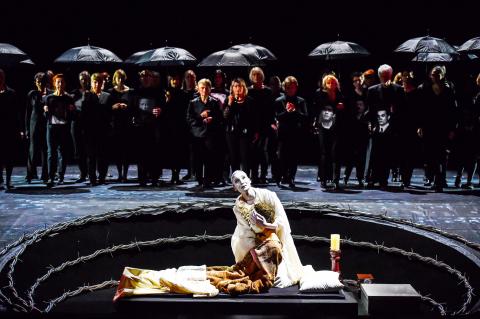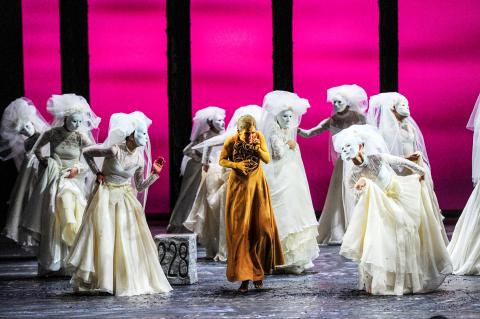After seeing Lin Mei-hong’s (林美虹) Schwanengesang (“Swan Song”) at the National Theater in 2010, I bemoaned the fact that this incredibly talented Yilan-born choreographer’s dance-theater works had never been seen in Taiwan before and voiced the hope that local audiences would have the chance to see more.
It took eight years before she was able to return, at the head of a different company, bringing TANZLIN.Z to perform The Little Mermaid at the National Taichung Theater in November last year.
Now, just seven months later she is coming back with the company, which will be performing one of her most critically acclaimed productions, Die Brautschminkerin (新娘妝), at the National Kaohsiung Center for the Arts (Weiwuying) next month at the invitation of Minister of Culture Cheng Li-chiun (鄭麗君).

Photo: Courtesy of Dieter Wuschanski
Lin created Die Brautschminkerin, which premiered in 2011, for her former company, the Tanztheater des Staatstheaters Darmstadt, and revived it two years ago for the Linz, Austria, troupe.
Die Brautschminkerin is based on Taiwanese writer Li Ang’s (李昂) short story Rouged Sacrifice (血妝彩祭), inspired by the horrors of the 228 Massacre in 1947.
Rouged Sacrifice tells of a woman whose husband is killed on their wedding night, and how she struggled to support herself and their son by working as a bridal make-up artist.

Photo: Courtesy of Dieter Wuschanski
The story is set in 1997 and examines the massacre and its repercussions through the eyes of two women, Mother Wang, whose husband was taken away by military police on their wedding night and executed, and a writer who wants to make a documentary about the massacre.
Central to Li’s story is that Taiwan had been suffering in silence for 50 years over the massacre, both the living and the ghosts or souls of the victims. A second key element is the repression of marginalized groups in Taiwan, for Mother Wang has been estranged from her son for years, having not spoken to him since learning that he was gay.
The two protagonists in Die Brautschminkerin are the mother of the past — the young bride who lost her groom on their wedding night — and the mother of the present — who has to confront the death of her son.
Haunting the stage are brides in white and groups of young men, while later a crowd of black-clad people of all ages wearing pictures of missing relatives, moving in silent protest against the world’s injustices.
Lin said Die Brautschminkerin allows women to express their pains, regrets and memories, and that she wanted to give a voice to those who are silenced, who are condemned to darkness.
However, she has said the piece is not just about Taiwanese history, but about the feelings of all those who have lived through coercion and the memories of those who have survived it, be it Spain in the 1930s, the atrocities of Nazi Germany to what is happening in many countries in the present day.
“One’s responsibility as an artist lies in experiencing the pulse of society and taking an interest in universal human values,” Lin said a talk at Weiwuying on June 1, “When Words Become Dance: Literature, Music and Images in Die Brautschminkerin.”
She also told the audience that she had been unsure about bringing Die Brautschminkerin to Taiwan, but as the European refugee crisis erupted in 2017, she realized that trauma and pain can occur anywhere.
Li also took part in the June 1 talk, and recounted how she met Lin at an international book festival, where they bonded over their common concern for human rights.
She told the audience that not only had she been in the audience of the 2011 premiere of Die Brautschminkerin, but has attended several other performances as well, including the premiere of the revival in February 2017.
Lin also drafted playwright and opera singer You Yuan-kiang (游源鏗), or A-kiang (阿鏗) as he is more commonly known, and France-based musician Yo Li-yu (游麗玉), famed for his gu-qin (古琴) compositions to give a Taiwanese flavor to the score for the production.
German arranger Michael Erhard pulled the disparate musical elements together, while Dirk Hofacker created the sets and costumes, as he did for The Little Mermaid.
Die Brautschminkerin runs about 80 minutes.

Many people noticed the flood of pro-China propaganda across a number of venues in recent weeks that looks like a coordinated assault on US Taiwan policy. It does look like an effort intended to influence the US before the meeting between US President Donald Trump and Chinese dictator Xi Jinping (習近平) over the weekend. Jennifer Kavanagh’s piece in the New York Times in September appears to be the opening strike of the current campaign. She followed up last week in the Lowy Interpreter, blaming the US for causing the PRC to escalate in the Philippines and Taiwan, saying that as

Taiwan can often feel woefully behind on global trends, from fashion to food, and influences can sometimes feel like the last on the metaphorical bandwagon. In the West, suddenly every burger is being smashed and honey has become “hot” and we’re all drinking orange wine. But it took a good while for a smash burger in Taipei to come across my radar. For the uninitiated, a smash burger is, well, a normal burger patty but smashed flat. Originally, I didn’t understand. Surely the best part of a burger is the thick patty with all the juiciness of the beef, the

This year’s Miss Universe in Thailand has been marred by ugly drama, with allegations of an insult to a beauty queen’s intellect, a walkout by pageant contestants and a tearful tantrum by the host. More than 120 women from across the world have gathered in Thailand, vying to be crowned Miss Universe in a contest considered one of the “big four” of global beauty pageants. But the runup has been dominated by the off-stage antics of the coiffed contestants and their Thai hosts, escalating into a feminist firestorm drawing the attention of Mexico’s president. On Tuesday, Mexican delegate Fatima Bosch staged a

Would you eat lab-grown chocolate? I requested a sample from California Cultured, a Sacramento-based company. Its chocolate, not yet commercially available, is made with techniques that have previously been used to synthesize other bioactive products like certain plant-derived pharmaceuticals for commercial sale. A few days later, it arrives. The morsel, barely bigger than a coffee bean, is supposed to be the flavor equivalent of a 70 percent to 80 percent dark chocolate. I tear open its sealed packet and a chocolatey aroma escapes — so far, so good. I pop it in my mouth. Slightly waxy and distinctly bitter, it boasts those bright,